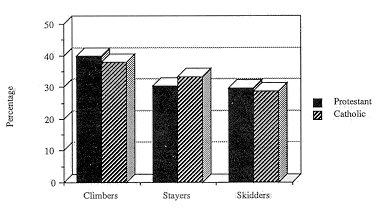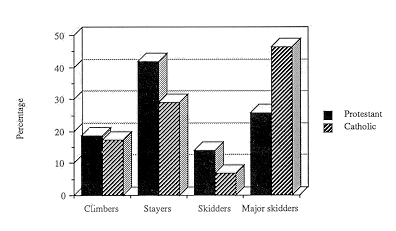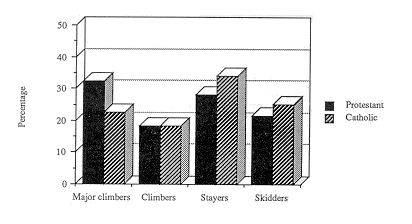Employment, Unemployment and Religion in Northern Ireland by A M Gallagher
INTRODUCTION Social mobility refers to the extent to which people move up, or down, the ladder of occupational status over time. Examining this process has particular relevance for fair employment in Northern Ireland: Roche et al., 1973/4 examine some factors related to mobility in Northern Ireland, while Cormack, Osborne and Thompson, 1980, examine mobility issues in relation to fair employment. One view of occupational differences between the two communities suggests that contemporary patterns are due to the perpetuation of past differences. Thus it is possible, on this view, that discrimination in employment in the past may account for present-day differences even though discrimination no longer plays a significant role. If this is the case then it is possible that employment differentials between the communities will erode and eventually disappear over time. Two methods are commonly used to examine social mobility levels. The first, an intra-generational study, follows the occupational careers of a group of people over a period of time. Due to the length of time needed for this method the more usual approach, an intergenerational study, is to compare the occupations of two succeeding generations: because the occupational careers of women differ radically from that of men, most inter-generational studies of mobility compare the occupational status of fathers and sons. This was the method adopted in the two studies to be described in this section. Hepburn (nd; 1983) compared social mobility levels in 1901 and 1951, while Miller (1979; 1981; 1983; 1986) examined levels of social mobility in 1973/4.
For his 1901 data Hepburn used a one-in-twenty-five sample of households in the Belfast County Borough drawn from the 1901 census. For each sample household he obtained the occupations of the male household head and his sons. For his 1951 data Hepburn used a one-in-three sample from the Belfast marriage register and compared the occupations of the groom with his father and father-in-law. Hepburn began by describing the industrial distributions of the two denominations in each year: he found that Catholics were under-represented in that part of manufacturing industry which included engineering, printing, shipbuilding and metal manufacture, the areas where the percentage of skilled and highly paid workers was highest. Catholics tended to be over-represented in domestic, mainly personal, services and in the much larger sector of industrial services (labouring). Hepburn found that the differences in industrial distributions of the two denominations was considerable in 1901 and had increased in 1951. The overall rate of social mobility had changed little between 1901 and 1951 and Catholic mobility was somewhat lower than that of other denominations in both years. The Catholic mobility rate had not changed between 1901 and 1951, and while there had been a slight decline in Protestant mobility the difference between the groups had narrowed only slightly and remained very clear.
Hepburn went on to examine upward mobility ('climbers') and downward mobility ('skidders') in two specific contexts: firstly that between manual and non-manual occupations, and secondly, within the manual category, between less-skilled and skilled occupations. Considering movement between manual and non-manual occupations first, Hepburn found a slight overall decline in 'climbers' in 1951, compared with 1901, but the Catholic rate had declined by half. In addition, while there was a higher rate of Protestant 'skidders' between these occupational categories in 1901, by 1951 the rate of Catholic 'skidders' was higher. Thus, comparing 1901 and 1951 the overall conclusion was that there were fewer Catholics than Protestants moving upwards from manual to non-manual occupations and more Catholics than Protestants moving downwards.
The pattern of mobility between less-skilled and skilled occupations was somewhat different, although here again Hepburn identified Catholic disadvantage. In 1951 there was a much higher rate of upward mobility of this kind than in 1901, and this was evident for both Catholics and Protestants. However, since the Protestant rate was higher in 1901, it remained higher in 1951. Related to this, there was a drop in the level of downward mobility from skilled to less-skilled occupations. Once again the rate of decline was similar in both groups but, since the Catholic rate had been higher in 1901, it remained higher in 1951.
Hepburn's overall conclusions were that over the period 1901 to 1951 Belfast remained a predominantly working-class city with non-manual employment difficult to climb into and easy to skid out of. Catholics were more likely to make unfavourable moves across this divide, ie from non-manual to manual occupations, while the Protestant picture showed no deterioration. Hepburn noted that because Protestants formed a larger proportion of the working population, in terms of numbers there remained more Protestants in the lower occupational groups. This, he suggests, would have made it harder to apply special corrective measures towards Catholics. Finally, Hepburn suggested that the disadvantageous position of Catholics at every level of the occupational hierarchy was mitigated somewhat by a substantial Catholic representation in white-collar employment, although he suggested that this was due largely to servicing their own community in a context of segregated districts and institutions.
Miller added to this historical mobility data by examining the situation in the early 1970s. His data were collected, in 1973 and early 1974, from a survey of a random, province-wide sample of 2,416 male adults between the ages of 18 and 64. Among the data collected were details of the educational and occupational careers of the respondents and their extended families. Miller's examination of social mobility compared the occupational levels attained by fathers and sons.
At an overall level Miller found that the predominant forms of father-son mobility were either short range mobility, ie between adjacent categories, or inheritance ie no movement; in other words, long-range mobility was very rare. Miller also found that manual and non-manual occupations made up two relatively closed systems of mobility. Thus, while most mobility was between adjacent categories, the least expected mobility was between the categories straddling the manual/non-manual divide.
In his examination of differences between the religious groups Miller found firstly that the occupational distributions were different for Catholics and Protestants, to the disadvantage of the former. This difference was found for both generations. Overall the mobility of Catholics and Protestants was equivalent, once the occupational distributions of the two generations were taken into account. However, Miller argued that because of the different occupational distributions, allied to the relative 'blockage' at the manual/non-manual divide, the mobility experience of Catholics and Protestants was not identical. In particular, Miller suggested that his analysis indicated a widening disparity in the occupational profiles of second generation Catholics, rather than a shrinking or stable gap. The first generation Catholics in his sample, Miller suggested, had been at an occupational disadvantage relative to first generation Protestants. However, this disadvantage had been widened and clarified in the second generation. Furthermore, this widening had not been due to poor or exceptional mobility performance by either group. Miller concluded that this evidence did not support the contention that inequalities in the present were simply due to a perpetuation of inequalities in the past.
Miller's conclusions are illustrated in figures 5.1 to 5.3. Figure 5.1 shows the overall pattern of movement for Protestants and Catholics in three categories: 'climbers' are where sons were at a higher occupational level than their fathers; 'stayers' are where the occupational levels of fathers and sons were the same; and 'skidders' are where sons were at a lower occupational level than their fathers. As figure 5.1 shows, the overall patterns of movement for Protestants and Catholics were fairly similar.



In figure 5.2 four categories of movement are illustrated: 'climbers' are where sons had a higher occupational level than their fathers; 'stayers' are where the occupational levels of fathers and sons were the same; 'skidders' are where sons had a lower non-manual occupational level than their fathers; and 'major skidders' are where sons had dropped to a manual occupational level. At an overall level figure 5.2 shows that where fathers had a non-manual occupation, the majority of sons also had a non-manual occupation. There is a clear religious difference however: a much higher proportion of the Protestant sons stayed in non-manual occupations, while a much higher proportion of the Catholic sons were major skidders into manual occupations. Mobility with fathers in manual occupations. Figure 5.3 shows similar patterns for those cases where the fathers had manual occupations. Here 'major climbers' are where sons had non-manual occupations; 'climbers' are where sons had a higher manual occupational level than their fathers; 'stayers' are where the occupational levels of fathers and sons were the same; and 'skidders' are where sons had a lower manual occupational level than their fathers. Again, at an overall level figure 5.3 shows that where fathers had manual occupations, most of the sons were also in manual occupations. There is also a religious difference revealed in these patterns, although it is not as marked as that for non-manual fathers. Figure 5.3 shows that proportionately more Protestant sons were major climbers, ie they had achieved non-manual occupations, while proportionately more Catholic sons were stayers or skidders.
Thus, while figure 5.1 shows that, at an overall level, the mobility experiences of Protestant and Catholic men are broadly similar, closer examination of the second generation mobility where fathers had non-manual (figure 5.2) and manual (figure 5.3) occupations reveals a widening disparity between the two communities. It is striking that this pattern of a widening disparity between the two communities was also found by Hepburn in his examination of mobility in 1901 and 1951. The clear significance of these patterns is that in the absence of social policy measures directed at employment differentials, the employment status gap between Protestants and Catholics was likely to increase, rather than stabilise or diminish. It may also be significant that the studies reported here were based on data collected before the first Fair Employment Act was introduced in 1976. This implies that a further study based on more recent data would be an appropriate method for assessing the impact of fair employment measures.
Data for figure 5.1: Overall pattern of social mobility by
religious affiliation (percentages)
Data for figure 5.2: Pattern of social mobility by religious
affiliation where fathers had non-manual occupations (percentages)
Data for figure 5.3: Pattern of social mobility by religious
affiliation where fathers had manual occupations (percentages)
| ||||||||||||||||||||||||||||||||||||||||||||||||||||||||